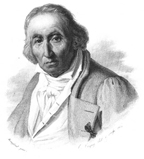Joseph-Marie Jacquard
Born July 7, 1752, Lyons, France, died August 7, 1834, Ouillins, France; in the late eighteenth century Jacquard developed a practical automatic loom which wove patterns controlled by a linked sequence of punched cards; Jacquard looms are still in use today throughout the world.

Jacquard's father was a silk weaver and his mother a pattern maker, but he pursued careers as a plasterer, cutler, type founder, and soldier, before he found an interest in his father's loom and began weaving fabric experimentally. His early career was during the period of the French Revolution and so he did not begin seriously to weave until the early years of Napoleon's reign. In 1803 Jacquard traveled to England to construct a loom to fabricate fish nets for the London Society of Arts. In February 1804 he completed the loom and was presented with the society's gold medal for his services, and 3000 FF for his efforts. Napoleon heard of Jacquard's achievements in England and summoned him to Paris to join the Conservatoire des Arts to work on looms for the Republic. Jacquard took the opportunity to study the automatic loom created by Jacques de Vaucanson in 1745, which, in turn, was based on the design of Falcon (1728), and used punched tape. [Vaucanson is perhaps most noted for his construction of a mechanical duck in 1738. The duck quacked, bathed, drank water, ate grain, digested it, and voided. It was described in detail by Voltaire.] Jacquard improved on Vaucanson's design by using punched cards to control the patterns which were to be woven. The cards were interconnected into a "program" and, as the weaving progressed, the cards passed over a perforated four-sided drum against which a set of needles, connected by wires to the warp threads, moved. The movement of the needles through the holes in the cards lifted the warp threads, allowing the filling threads to be passed over or under the warp, thus creating the pattern.
In 1806 Napoleon, pleased with Jacquard's progress, granted him a pension of 3000 FF on condition that he move his operations to the city of Lyons. However, the fear of automation preceded Jacquard and he was forced to flee for his life from the anger of weavers who believed that they were about to lose their livelihood. Against these odds Jacquard persevered and eventually Lyons became the major center of weaving using the Jacquard loom. By the time that Jacquard died in 1834, over 30,000 looms existed in Lyons alone. Jacquard looms, only slightly modified, are still in use today and are the source of exquisite fabrics for furniture.
Charles Babbage is believed to have obtained his ideas for the use of punched cards in the control of the Analytical Engine from his knowledge of the Jacquard loom, but it was Herman Hollerith who put cards to the most diverse use in his tabulators. [Babbage owned a self-portrait of Jacquard, created on a loom, which had all the appearance of an engraving. See Wilkes, M.V, Automatic Digital Computers, John Wiley & Sons, New York, 1956. Additionally, it may be noted that Ada Augusta, in describing the Analytical Engine, likened the action of the machine to "weaving patterns."] However, it is important to note that both Jacquard and Babbage intended to use the cards to store programs; Hollerith used the cards for data.
BIBLIOGRAPHY
Biographical
Posselt, E.A., The Jacquard Machine Analyzed and Explained: With an Appendix on the Preparation of Jacquard Cards, and Practical Hints to Learners of Jacquard Designing, Pennsylvania Museum and School of Ind. Art., Philadelphia, 1887.
UPDATES
The image, mentioned in the footnote, owned by Charles Babbage is the same image as contained in the portrait in this entry. (MRW, 2013)
New content Copyright © 2013-2023 by the IEEE Computer Society and the Institute of Electrical and Electronics Engineers Inc.
All rights reserved. This material may not be reproduced or redistributed without the express written permission of the copyright holder.
